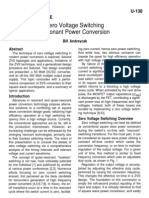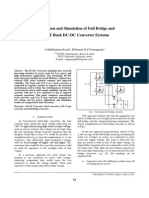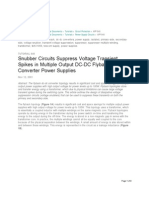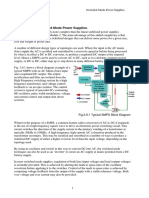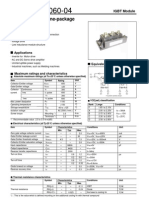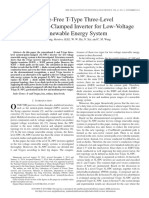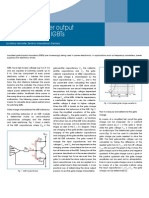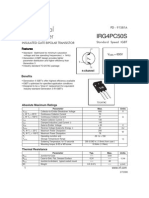Clamp
Clamp
Uploaded by
Gaetano GaetanoCopyright:
Available Formats
Clamp
Clamp
Uploaded by
Gaetano GaetanoOriginal Description:
Copyright
Available Formats
Share this document
Did you find this document useful?
Is this content inappropriate?
Copyright:
Available Formats
Clamp
Clamp
Uploaded by
Gaetano GaetanoCopyright:
Available Formats
IEEE TRANSACTIONS ON POWER ELECTRONICS, VOL. 11, NO.
1, JANUARY 1996
162
ization of an Active-Clamp Circuit to
ve Soft Switchi g in Flyback Converters
Robert Watson, StudentMember, IEEE, Fred C. Lee, Fellow, IEEE, and Guichao C. Hua
Abstract-Flyback derived topologies are attractive because of
their relative simplicity when compared with other topologies
used in low power applications. Incorporation of active-clamp
circuitry into the flyback topology serves to recycle transformer
leakage energy while minimizing switch voltage stress. The addition of the activef-clamp circuit also provides a mechanism for
achieving zero-voltage-switching(ZVS) of both the primary and
auxiliary switches. ZVS also limits the turn-off d i / d t of the output
rectifier, reducing rectifier switching losses, and switching noise
due to diode reverse recovery. This paper analyzes the behavior
of the ZVS active-clamp flyback operating with unidirectional
magnetizing current and presents design equations based on this
analysis. Experimental results are then given for a 500 W prototype circuit illustrating the soft-switching characteristics and
improved efficiency of the converter. Results from the application
of the active-clamp circuit as a low-loss turn-off snubber for
IGBT switches is also presented.
@vm
t
k
6
Fig. 1. Simplified schematic of the active-clamp flyback converter.
I. INTRODUCTION
HE flyback topology has long been attractive because
of its relative simplicity when compared with other
topologies used in low power (up to several hundred watts)
applications. The flyback transformer serves the dual purpose of providing energy storage as well as converter isolation,
theoretically minimizing the magnetic component count when
compared with, for example, the forward converter. A drawback to the use of the flyback is the relatively high voltage and
current stress suffered by its switching components. High peak
and RMS current stress is a particular problem for flybacks
when operating in discontinuous conduction mode (DCM) and
is in fact a primary detriment to increasing output power.
An addition, high turn-off voltage (caused by the parasitic
oscillation between the transformer leakage inductance and the
switch capacitance) seen by the primary switch traditionally
requires the use of an RCD clamp to limit the switch voltage
excursion. Unfortunately, in this scheme the energy stored in
the transformer leakage is dissipated in the clamp resistor,
resulting in a difficult design trade-off between clamping
action and clamp circuit power dissipation.
The limitations presented by the RCD clamp can be largely
overcome by replacing the passive clamp with an activeclamp circuit, as shown in Fig. 1. Active-clamp methods have
been explored in detail for forward converters [7], [XI. The
active-clamp circuit provides the benefits of recycling the
transformer leakage energy while minimizing turr-off voltage
Manuscript received June 15, 1994, revised July 12, 1995 This work was
supported by Zytec Corporation
The authors are with the Virginia Power Electronics Center, Bradley
Department of Electrical Engineenng, Virginia Polytechnic Institute and State
University, Blacksburg, VA 24061 USA
Publisher Item Identifier S 0885-8993(96)00603-5.
stress across the power switch. In addition, the active-clamp
circuit provides a means of achieving zero-voltage-switching
(ZVS) for the power switch and subsequent lowering of
the output rectifier di/dt. This results in decreased rectifier
switching loss and output switching noise. To achieve softswitching characteristics over a useful operating range, the
addition of a small resonant inductor in the active-clamp loop
is usually necessary (see Fig. 1).
The use of the active-clamp circuit to achieve soft switching
in flybacks operating with bidirectional magnetizing current is
well documented [ 11-[3]. By bidirectional magnetizing current
it is meant that the flyback transformer ripple current is
allowed to become negative (i.e., reverse direction relative
to magnetizing current flow defined in Fig. 1) for a portion
of each switching cycle. This is only possible in conjunction
with the operation of the active-clamp network. The (negative)
magnetizing current can then be used to discharge the primary
switch capacitance and achieve ZVS. However, for higher
output power operation, it is more desirable to minimize the
transformers ripple current content to reduce device current
stress [4], IS].This is directly analogous to CCM versus DCM
operation in conventional flyback converters, where, given
identical operating conditions, DCM op
greater device peak current stress and
CCM operation. However, ZVS can s
unidirectional magnetizing current by utilizi
stored in the resonant inductor [6]. The
resonant inductor also helps to softly com
of the output rectifier, resulting in reduced
rectifier switching losses. This would be a parti
in high output voltage applications where slower rectifiers are
more likely to be used.
0885-8993/96$05 .OO 0 1996 IEEE
WATSON et al.: ACTIVE-CLAMP CIRCUIT TO ACHIEVE SOFT SWITCHING IN FLYBACK CONVERTERS
163
0
0
Vm
0
0
0
T X T A
T4 T5
. ..
T5 -T6
-
T6- T7
Fig. 2. Active-clamp flyback topological states
This paper presents evaluation of a constant-frequency, softswitching, active-clamp flyback converter for dcldc conversion
applications. The basic principle of operation is analyzed and a
design procedure is developed. Experimental results are then
presented, which illustrate converter function and verify the
analysis presented.
11. ACTIVE-CLAMP
FLYBACK
CONVERTER
OVERVIEW
The incorporation of an active-clamp circuit into the basic
flyback topology is shown in Fig. 1. In the figure, the flyback transformer has been replaced with an equivalent circuit
model showing the magnetizing and leakage inductances ( L ,
represents the total transformer leakage inductance reflected to
the primary in addition to any external inductance). Switches
S1 and S2 are shown with their associated body diodes. C,
represents the parallel combination of the parasitic capacitance
of the two switches. It is this device capacitance resonating
with L, that enables ZVS for S1. With the active-clamp
circuit, the transistor turn-off voltage spike is clamped, the
transformer leakage energy is recycled, and zero-voltageswitching (ZVS) for both primary (Sl) and auxiliary ( S 2 )
switches becomes a possibility. These advantages come at the
expense of additional power stage components and increased
control circuit complexity (two switches as opposed to the
usual one switch).
Fig. 2 illustrates the topological states and Fig. 3 the key
waveforms for the active-clamp flyback converter. For this
description of circuit operation (and for the subsequent development of a design procedure in the next section), the
following assumptions are made:
ideal switching components,
the magnetizing current is always nonzero and positive
(positive direction as defined by Fig. I),
Fig. 3. Active-clamp flyback steady-state waveforms.
L, (includes the transformer leakage inductance) is much
less than the transformer magnetizing inductance, L ,
(typically 5% to 10% of L,),
sufficient energy is stored in L, to completely discharge
C, and turn on Sl's body diode, and
>> Toff.
The last assumption simply states that one-half the resonant
period formed by L, and Cclampis much longer than the
maximum off time of S1(T0~
E (1 - D)Ts).The sequence
of topological states is described below.
To-Tl: At TO,switch S1 is on, and the auxiliary switch,
S2, is off. The output rectifier, D1, is reversed biased as is the
antiparallel diode of 5'2. The magnetizing inductance (along
with the resonant inductance) is being linearly charged, just
as it would be during the inductor charging phase in "normal"
flyback operation.
T I - T ~ :S1 is turned off at T I . C, is charged by the
magnetizing current (which is also equal to the current through
the resonant inductor). C, is actually charged in a resonant
manner, but the charge time is very brief, leading to an
approximately linear charging characteristic.
Tz-T~:At T2, C, is charged (V& = I&,
Vc)to the
point where the antiparallel diode of S2 starts to conduct.
The clamp capacitor fixes the voltage across L, and the
transformer magnetizing inductance to V ,( S N G ) , forming
a voltage divider between the two inductances. Since Cclamp
is much larger than C,, nearly all of the magnetizing current
is diverted through the diode to charge the clamp capacitor.
Consequently, the voltage appearing across the magnetizing
IEEE TRANSACTIONS ON POWER ELECTRONICS, VOL. 11, NO. 1, JANUARY 1996
164
inductance, Vpri, decreases as V, increases, according to the
voltage divider action described by (1)
Vpri =
-v' L , L,+ L,'
T3-T4: At T3, Vpr; has decreased to the point where the
secondary transformer voltage is sufficient to forward bias
D1. The transformer primary voltage is then clamped by the
(very large) output capacitance to approximately NVo. L, and
Cclamp
begin to resonate. In order for S2 to achieve ZVS, the
device should be turned on before IcClamp
reverses direction.
T4-T5: The auxiliary switch, S2, is turned off at T4,
effectively removing Cclamp
from the circuit. A new resonant
network is formed between the resonant inductor and the
MOSFET parasitic capacitances. The transformer primary
voltage remains clamped at NVo as C, is discharged.
T5-T6: Assuming the energy stored in L, is greater than the
energy stored in C,, at T5CT will be sufficiently discharged to
allow Sl's body diode to start conducting. The voltage across
the resonant inductor becomes clamped at V,, NVo. This
also fixes the rate of decay of the output rectifier current to
For L,
>> L,, (2) simplifies to
diDl
- N
dt
-N
V,n
+ NVO
LT
(3)
It is during this interval that switch S1 can be turned on under
zero-voltage conditions.
T6-T7: S1 is on, and the secondary current is decreasing as
the resonant inductor current increases. At T7, the secondary
current decreases to zero (because the resonant inductor current has equaled the magnetizing current), and D1 reverse
biases, allowing the polarity to reverse on the transformer
primary. The magnetizing and resonant inductances begin to
linearly charge again, starting another switching cycle (T7 =
In addition to the S l / S 2 timing requirement. there must
also be sufficient energy stored in the resonant inductor to
completely discharge the switch capacitance. This requirement
is valid at time instant T4 (when S2 is turned off)
EL? 2 Ec,
I ~ ~ 2 t u off
r n
(5)
It should be noted that even if insufficient energy is stored in
L, to completely discharge the switch capacitance, meeting the
timing requirement called for in (4) guarantees switching with
the minimum possible voltage stress for the given operating
condition. Equation ( 5 ) can be used to develop a design
equation determining an appropriate resonant inductor value
that realizes ZVS at a desired operating point. This will be
detailed in the section concerned with the design of L,.
A. ZVS Active-Clamp Flyback Design Procedure
1 ) Select Flyback Transformer Inductance
of the active-clamp circuit does not significantly alter the
primary switch current waveform from that seen in non-activeclamp CCM flyback designs. Therefore, the usual methods of
determining the appropriate value of magnetizing inductance
can be used. Of course, the peak and RMS switch currents are
heavily influenced by the amount of allowed inductor ripple
current. This is usually expressed as some percentage of the
maximum average inductor current (occurring at m
load and minimum line) so as to limit switch currents.
2) Select Transfoimer Turns Ratio: The transformer turns
ratio is chosen to accommodate as low a voltage rating for the
switching devices as possible while still being able to realize
a reasonable range of duty cycles over the input line range.
Assuming that the active clamping provides for perfect voltage
clamping across the primary switch (i.e., no overshoot), then
the maximum off-state voltage appearing across S1 and S2
is given by
TO).
Note that the length of the time intervals TI to T3 and T4
to T7 have been greatly exaggerated in Fig. 3 in order to more The last part of the expression in (6) is the value of the
voltage developed across L,. Although an explicit value of
clearly show the transition periods.
the resonant inductor hasn't yet been determined, for the
purposes of estimating the maximum voltage stress on S1
111. SOFT-SWITCHING
FLYBACKDESIGNCONSIDERATIONS and S2 a value of L,/10 can be used as a conservative
For the purposes of ZVS of S1,there must be assurance that design guideline. Also, as long as L , >> L, the converter dut
the switch is turned on during the T5 to T6 time interval. If cycle behavior is approximately the same as for a non-act
not, the resonant inductor current reverses (becoming positive clamp flyback operating in CCM. With the addition of L,, the
again), recharging C,, and ZVS is lost (or at least partially effective duty cycle (as defined by the charge and discharge
lost). Therefore, the delay time between the turn off of S2 and cycle of the flyback inductor) is slightly less than switch S l ' s
the turn on of S1 is critical to ZVS operation. The optimum duty cycle (see Fig. 3)
value of this delay is one-quarter of the resonant period formed
by L, and C,
(4)
Strictly speaking, the value of C, is a function of applied
voltage (particularly at small drain-to-source voltages), but (4)
simplifies matters by assuming that it is not.
Equation (7) is approximate in that it assumes lossless switching. In this application A D M 5% of Dsl so for the purposes
of developing (6) and subsequent design equations it will be
assumed D = Deff = Dsl.
165
WATSON et al.:ACTIVE-CLAMP CIRCUIT TO ACHIEVE SOFT SWITCHING IN FLYBACK CONVERTERS
3) Design Resonant Inductor: After the value of L, has
been fixed, the resonant inductor can be designed. As mentioned previously, it is assumed its value will be a small
fraction of L,. For a given converter operating point and
value of C,, achieving ZVS requires that L, be of sufficient
size to completely discharge the switch capacitance. At time
instant T4, from (5)
IS1,peak
=I
ILm,peak
= IL,,peak 2
vCT
(8)
where the peak primary switch current is
(9)
The difficulty in solving (8) for L, is the fact that the resonant
capacitor voltage (V&) is a function of the value of L,.
However, in a practical design situation, the resonant inductor
voltage at T4 is relatively small (compared to
+ NVo) and
(8) can be solved for an approximate minimum value of L,
necessary to achieve ZVS
v,
51
,peak
be necessary to complicate the implementation of S2 by
defeating its slow body diode by placing a diode in series
with 52 and placing a fast recovery rectifier in parallel with
the S2-diode series combination. This will prevent conduction
of S2s body diode, necessary if a condition in the circuit ever
occurred where S2s body diode was conducting when S1 is
turned on. This could possibly occur, for example, during a
line or load transient. Of course, the possibility of ZVS for S 2
is lost using such a realization.
5) Select Clamp Capacitor: Choosing the value of clamp
capacitance is done based on the design of L,. The resonant
frequency formed by the clamp capacitor and the resonant
inductor should be sufficiently low so that there is not excessive resonant ringing across the power switch when the
switch is turned off. However, using too large a value of clamp
capacitance yields no improvement in clamping performance
at the expense of a larger (more costly and bulky) capacitor.
A good compromise for design purposes is to select the
capacitor value so that one-half of the resonant period formed
by the clamp capacitor and resonant inductance exceeds the
maximum off time of S1.Therefore
Cclamp
In applications requiring high output voltage, it may be more
desirable to specifically tailor the soft-switching characteristics
of the output rectifier than to necessarily realize ZVS of the
primary switch. In this case, (3) may be the more important
design criteria for the resonant inductor.
The RMS current carried by L, can be estimated from (11)
(1 - DHL)
,rr2L,F,2
The capacitor voltage rating has to exceed NVo by the amount
of voltage dropped across L,
The required ripple current rating for the capacitor is
JL,,RMS
1 DLL
Icclamp,EMS
max
I z t l a m p -/ F .
(11)
The expression for this current is complicated by the fact
that the resonant inductor carries both primary switch and
circulating clamp current.
4 ) Select Auxiliary Switch: For the purposes of estimating
the required current rating of S2, advantage is taken of the
assumption that the L, - Cclamp resonant period is much
longer than the off time of S1.Under this assumption, the
approximates a sawtooth
current through S2 (same as
waveform with endpoint currents equal to the peak current
through S1 (see Fig. 3). The MOSFET body diode conducts
clamp current for half the S2 on time with the MOSFET
itself conducting current for the remaining half of the cycle.
Therefore, the worst case maximum currents seen by both the
MOSFET and its body diode are approximately
and
where the peak primary switch current can be obtained from
(9). It should be noted that as a practical matter it may
(16)
Equation (16) was derived using the same simplifying assumption used to derive (12) and (13).
6) Choose Output Rectifier: The maximum theoretical reverse voltage seen by the output rectifier in the active-clamp
flyback is the same as for a standard flyback design. However,
the rectifier current is another matter. Due to the presence of
the clamp circuit, the secondary current is discontinuous in
shape even though the flyback inductor magnetizing current
is always positive and greater than zero. This is illustrated in
Fig. 3. The result is much higher peak secondary currents than
would normally be expected in a non-active-clamp flyback
operating in CCM
Ig?;eak
2pFX
Vo(1 - DLL)
The average rectifier current is just the load current. As was
pointed out previously, the addition of L, reduces the rate of
diode turn-off d i l d t . This improves rectifier switching losses
and converter noise levels (see Figs. 6-8).
7) Select Output Capacitor(s): The principal factor affecting the value of output capacitance is utilization of enough
capacitance to meet device ripple current ratings
E E E TRANSACTIONS ON POWER ELECTRONICS, VOL. 11, NO. 1, JANUARY 1996
166
Efficiency (h)
Output Power (W)
Fig. 4. Efficiency comparison between RCD and active-clamp configmations. For RCD clamp, R = 4.7 K.Q, 10 W, and C = 2.2 pF.
Theoretically, the capacitance value would be selected based
on output voltage ripple specifications. However, in practice,
meeting the RMS current rating called for in (18) sets a lower
limit on an amount of capacitance that usually easily meets
any ripple voltage specification.
8) Design Flyback Transformer: Still constrained by the
assumption that L, << L,, the transformer design for the
active-clamp flyback is no different than that for a non-activeclamp CCM flyback, except the primary and secondary RMS
currents are somewhat different. The transformer secondary
and output rectifier RMS currents are equivalent, so
Fig. 5 . ZVS active-clamp flyback experimental waveforms. Top trace:
vgs,sl@ 15 V/div.; middle trace: I L , @ 5 A/div.; bottom trace: vds,S1
@ 100 V/div. Time scale is 1 ps/div.
0 --
--
Fig. 6. Output rectifier current waveforms @ 10 A/div. Toptrace.
N 2 pH. Time scale is 500 ns/div.
The transformer primary current is identical to the resonant L , = 7 p H ; bottom trace: L , =
inductor current, consequently its RMS value is given by (1 1).
Clamp circuit:
I v . EXPERIMENTAL
RESULTS
To experimentally characterize the soft-switching properties of the active-clamp flyback converter, a breadboard was
constructed to the specifications listed below:
input voltage: 100 VDC
output voltage: 48 VDC
* output power: 500 W maximum
switching frequency: 100 kHz
Using the design procedure discussed in the previous section
as a guide, the experimental converter was constructed using
0
0
the following components:
0
Transformer:
core: Toshiba PC40ETD49-Z
primary: 45T of 3 strands of 150/42 Litz wire
secondary: 15T of 5 strands of 150/42 Litz wire
L,: 215 pH, &ak (referred to primary): 2.3 pH
Resonant inductor:
core: MPP 55530
winding: 8T of 10 strands of AWG 26
L,: 7 pH (with no bias)
Cclamp:
2.2 pF, 250 V
S2: IRFF360
* 51: ESP360
* Output stage:
D1 : 2xBYV44-500
CO: 3 x 2200 pF, 100 V Aluminum electrolytic.
For the experimental circuit, ZVS was realized above
145 W. Fig. 4 compares experimental efficiencies using an
RCD clamp with no resonant inductor and the active-clamp
circuit with L, = 7 pH (all other circuit parameters are
identical). It can be seen that the active-clamp circuit yields
an improvement of at least -4% in power stage efficiency.
Maximum output power for the RCD clamped power stage
is about 250 W due to power dissipation limitations in the
clamp resistor.
Figs. 5 and 6 are experimental waveforms pertinent to illustrating the converters soft-switching characteristics. Fig. 5
displays S l s gate drive voltage, the resonant inductor current,
and Sls drain-to-source voltage. Operation is at Po = 300 W.
Fig. 6 compares the output rectifier current with and without
L, in the circuit. The operating point of the converter is
identical for both cases (Po = 300 W, ZVS with L,, hard
WATSON et al.: ACTIVE-CLAMP CIRCUIT TO ACHIEVE SOFT SWITCHING IN FLYBACK CONVERTERS
167
Efficiency ph)
IRGPC4OU
--c
IRGPC4OU. Cr = 3000 pF
m s o
.-..-.
IRFpcso~~m5o
-..-..
Output Power (W)
Fig. 9. Efficiency comparison using the active-clamp network with various
switch configurations. FS = 100 kHz.
Fig. 7. Output voltage noise, L , =
Experimental results comparing power stage efficiencies
using an IGBT with and without external capacitance is shown
in Fig. 9. With C, = 3000 pF, the efficiency is improved by
about 1% over most of the load range. Also, for comparison
purposes, efficiencies for a single and dual 600 V MOSFETs
are plotted. As can be seen, at PO= 400 W circuit efficiency
using a single IGBT is equal to the efficiency obtained using
two MOSFETs.
Lleak.
V. CONCLUSION
RES S W 3
kHZ
VBW 3 kHZ
SWP 1.0
sec
Fig. 8. Output voltage noise, L , = 7 pH.
switching without it). As can be seen from the figure, with
the resonant inductor the rectifier reverse recovery current
characteristic is substantially improved. Not only is switching
loss in the diode decreased, but the output voltage highfrequency (HF) noise is reduced. This is illustrated in Figs. 7
and 8, which show the output voltage noise spectrum with
and without L,. In particular, the noise levels in the frequency
range of about 2.5-3 MHz show a reduction of nearly 20 dB
between the two cases. Coincidentally, HF noise in the range
of about 2-5 MHz is typically very difficult to filter because
the frequency is somewhat low for effective use of ferrite beads
and is too high for standard capacitive bypassing.
Another attractive usage for the active-clamp circuit is
as a low-loss turn-off snubber when using an IGBT as the
primary switch device (51).IGBTs have superior conduction
characteristics compared to MOSFETs (of the same voltage
rating). The drawback to the use of IGBTs is that they
display excessive turn-off losses 3s their switching frequency
is increased. The severity of this problem can be reduced by
adding an external capacitor (C,) from the collector to the
emitter of the IGBT to slow down the rate of increase in
collector voltage as the device turns off. This allows time for
the device current to tail to zero without excessive device
voltage being present. Subsequently, before S1 is turned on,
the resonant inductor discharges C, so that its stored energy
is not dissipated in the IGBT at device turn on.
This paper has presented the analysis, design, and experimental results for a high-efficiency 500 W flyback dcldc
converter employing active-clamp circuitry. The incorporation
of the active-clamp circuit into the basic flyback topology
provides a mechanism for achieving ZVS for both the primary
and auxiliary switches and soft commutation of the output rectifier while operating with low ripple (unidirectional) current
in the flyback transformer. Low ripple current operation is
desirable as power levels of several hundred watts can realize
higher efficiencies than when compared with a non-activeclamp flyback operating in DCM or an active-clamp flyback
operating with high ripple currents.
APPENDIX
In this appendix are outlines of the derivations of the
equations that appear in the section of the paper describing
the design procedure [(6)-(19)]. Here we make the following
simplifying assumptions:
The clamp current is piecewise linear instead of quasisinusoidal.
Clamp capacitor voltage is constant (i.e., clamp capacitor
is assumed infinite in value).
The duration of the intervals Tl-T2 and T4-T6, shown
in Fig. 3, is short enough compared with the duration of
interval Tl-T6 to allow them to be neglected.
de^
= Dsl.
Equation (6): Fig. 10 shows the idealized clamp current
waveform and the simplified circuit topology during switch
51s off time. The switch voltage is given by
The peak switch current (which is equal to the peak magnetizing current and peak resonant inductor current) is determined
by applying the principal of power balance to the converter.
IEEE TRANSACTIONS ON POWER ELECTRONICS, VOL. 11, NO. 1, JANUARY 1996
168
the assumption of small duty cycle loss, VL?<< V,, NVo
during clamping portion of the switching cycle. Therefore, for
zvs of s1
-LriZ,
2l
2 5CrVz7
l@S2turn-off
1QS2 turn-off
(23)
For VC,.M V,, NVo (23) can be solved for Lr to yield (10).
Equation (11): The RMS current flowing in the resonant
inductor can be calculated with the aid of Figs. 3 and 11. If
we assume negligible duty cycle loss, the slope of the resonant
inductor current becomes infinite during the T 4 T 7 interval
shown in Fig. 3 (i.e., the duration of the T4-T7 interval
is zero). The RMS value of the current can then be more
easily approximated using two piecewise linear intervals over
a switching cycle
(b)
Fig. 10. (a) Idealized clamp capacitor current waveform. (b) Simplified
topological state S1 off, S2 on.
S1
s2
Lm
Integrating (24) yields an expression for the RMS current in
terms of the peak switch current. Equation (9) can then be
used to obtain (11).
Equations (12) and (13): Both of these equations can be
derived with the aid of Fig. 10. It is assumed the body diode
of 52 will conduct the positive portion of the clamp current
and the MOSFET will conduct the negative portion. With a
linear clamp current waveform and equal but opposite endpoint
values, this implies each part of S 2 will conduct for half of
the (1 - D)Ts interval. Therefore, the average body diode
current is
Lr
I S 2 body diode,avg E
Fig. 11. Idealized waveforms for computing effective duty cycle.
Under the assumptions stated above, the expression for the
peak switch current is the same as that obtained for a nonactive-clamp CCM flyback. This is simply the average inductor
current plus one-half of the peak-to-peak inductor ripple
current, and is given by (9). Substituting (9) into (20) results
in (6).
Equation (7): Referring to Fig. 11, the duration of the
interval ADTs is given by
ADT -
Lr
- V,,+NVo
(iL,,peak
+ iL,,valley). (21)
We now need an expression for the second factor in (21)
in terms of Ds1. Resorting to power balance and assuming
A D << Dsl yields
Substituting (22) into (21) yields the second part of the
expression given in (7).
Equations (8) and (10): Equation (8) follows directly from
(5). Equation (10) is complicated by the fact that the resonant
capacitor voltage is a function of the resonant inductor voltage,
which is given by the middle term in (20). However, under
The MOSFET
(4 d t
iCclamp
1-D
iSl, peak-
c ~ ~ eisn obtained
t
in a Similar m m ~ r
IS2, MOSFET,RMS E
@=Er---
- iSl,peak
/?*
i&,,,,
( t )d t
(26)
Equations (14)-(16): Equation (14) results from the resonance between L, and C c l a m p . We want half the resonant
period to be greater than S l s maximum off-time
Equation (27) can be solved for C c l a m p to yield (14). Once an
expression is found for the resonant inductor voltage during
the clamping cycle [middle term of (20)], the derivation of (15)
is straightforward.Equation (16) can be derived from Fig. 10
WATSON et al.: ACTIVE-CLAMP CIRCUIT TO ACHIEVE SOFT SWITCHING IN FLYBACK CONVERTERS
169
[SI C. Leu, G. Hua, and F. Lee, Comparison of forward topologies with
various reset schemes, in Proc. 9th Ann. VPEC Power Electron. Sem.,
1991, pp. 101-109.
<iD1> = Io
Fig. 12. Simplified output rectifier waveform.
Equations (17)-(19): Equations (17)-( 19) can be derived
with the aid of Fig. 12. As shown in the figure, the diode
current waveform has been approximated as piecewise linear.
This reflects the assumption that the clamp capacitor current
is linear during the clamping interval. Once again, if it is
assumed L, << L,, the rectifier turn-off current slope can
be approximated as infinite. The peak diode current can be
obtained from knowledge of the average rectifier current
Robert Watson (S93) was born in 1958 in Indianapolis, IN. He received the B.S.E.E. degree
in 1982 from Purdue University, West Lafayette,
Indiana and the M.S.E.E. degree in 1986 from
the University of Arizona in Tucson. Currently, he
is a Ph.D. candidate in electrical engineering at
Virginia Polytechnic Insbtute and State University
in Blacksburg.
Prior to joining the Virginia Power Electronics
Center (VPEC) at VPI&SU as a Research Assistant
in 1992, Mr. Watson split 10 years of industrial
employment between Hughes Aircraft Company and Bendix Engine Controls,
a division of Allied-Signal Corporation. Currently, he is a Research Associate at VPEC, specializing in dc and high-frequency ac distributed power
architectures, high-frequency power conversion, and power factor correction
applications.
Mr. Watson is a member of Phi Kappa Phi and was a Hughes Aircraft
Company Fellow in 1985 and 1986.
REFERENCES
Fred C. Lee (S72-M74-SM87-F90) received
the B.S. degree in electrical engineering from National Cheng Kung University in Taiwan in 1968,
and the M.S. and Ph.D. degrees from Duke University, Durham, NC in 1971 and 1974, respectively.
He holds the Lewis A. Hester Chair of Engineering at Virginia Tech, and was the James S. Tucker
Endowed Professor in the Bradley Department of
Electrical Engineenng. He is the founder and director of the Virginia Power Electronics Center
(VPEC), a Technology Development Center of the
Center for Innovative Technology (CIT). Under his leadership, VPEC has
become one of the largest university-based power electronics research centers
in the country. The Centers Industry Partnership Program has enrolled more
than 70 companies around the world. His research interests include highfrequency power conversion, distributed power systems, space power systems,
device characterization, and modeling and control of converters and design
optimization. During his career, he has published more than 100 referred
journal papers, more than 200 technical papers in national and intemational
conferences, and over 150 industry and government reports. He currently
holds 14 U.S. patents.
Dr. Lee is a recipient of the 1985 Ralph R. Teeter Educational Award of
the Society of Automotive Engineering, the 1989 William E. Newel1 Power
Electronics Award of the IEEE Power Electronics Society, the 1990 PCIM
Award for Leadership in Power Electronics Education, and the 1990 Virginia
Tech Alumni Award for Research Excellence. He is a Past President of the
IEEE Power Electronics Society.
[l] C. Henze, H. Martin, and D. Parsley, Zero-voltage switching in high
frequency power converters using pulse width modulation, in Proc. 3rd
Ann. Appl. Power Electron. Con$, 1988, pp. 33-40.
[2] H. Martin, Topology for miniature power supply with low voltage and
low ripple requirements, U.S. Patent 4618 919.
[3] K. Yoshida, T. Ishii, and N. Nagagata, Zero voltage switching approach
for flyback converter, in Proc. 14th lnt. Telecomm. Energy Con$, 1992,
pp. 324-329.
[4] W. Tang, E. Yang, and F. Lee, Loss comparison and subharmonic issue
on flyback power factor correction circuit, in Proc. 11th Annu. VPEC
Power Electron. Sem., 1993, pp. 125-131.
[51 R. Watson, G . Hua, and F. Lee, Characterization of an active clamp
flyback topology for power factor correction applications, in Proc. 9th
Ann. Appl. Power Electron. Con$, 1994, pp. 412418.
[6] K. Harada and H. Sakamoto, Switched snubber for high frequency
switching, in Proc. Power Electron. Spec. Conf, 1990, pp. 181-187.
[7] B. Carsten, Design techniques for transformer active reset circuits at
high frequency and power levels, in High Freq. Power Conversion
Con$ Proc., 1990, pp. 235-245.
Guichao C. Hua received the B.S. and M.S. degrees
in electrical engineering from Zhejiang University
in China in 1985 and 1988, respectively, and the
Ph.D. degree from Virginia Tech, Blacksburg, in
1994.
From 1988 to 1989, he was employed as a power
supply design engineer at Watt Power Supply Corp.
in China. He joined the Virginia Power Electronics
Center (VPEC) In 1989 and became a Research
Associate in 1991 and a Research Scientist in 1994.
He is currently with the Virginia Power Technologies in Blacksburg. He has published more than 40 papers and holds two
U.S. patents. His research interests include high-frequency power conversion,
new converterhnverter topologies, power-factor correction circuits, distributed
power systems, piezo-electric transformers, and UPS systems.
The output capacitor ripple current is equivalent to the output
rectifier RMS current with the DC portion of the current
removed. Therefore, two intervals of integration have to be
considered
Integrating (30) and using the result of (17) yields (18). The
transformer secondary is in series with the output rectifier, so
their RMS currents are identical. Since the dc component of
current is present, we have
Integrating (31) and using the result of (17) yields (19).
You might also like
- Comparison and Simulation of Full Bridge and LCL-T Buck DC-DC Converter SystemsNo ratings yetComparison and Simulation of Full Bridge and LCL-T Buck DC-DC Converter Systems5 pages
- DC-DC Converter: Four Switches V V 2, Capacitive Turn-Off Snubbing, ZV Turn-OnNo ratings yetDC-DC Converter: Four Switches V V 2, Capacitive Turn-Off Snubbing, ZV Turn-On10 pages
- Novel Zero-Current-Transition PWM Converters: Eric X. CNo ratings yetNovel Zero-Current-Transition PWM Converters: Eric X. C6 pages
- Design and Application For PV Generation System Using A Soft-Switching Boost Converter With SARCNo ratings yetDesign and Application For PV Generation System Using A Soft-Switching Boost Converter With SARC13 pages
- A New ZVZCS Isolated Dual Series Resonant DC-DCNo ratings yetA New ZVZCS Isolated Dual Series Resonant DC-DC9 pages
- Dire Dawa University: Institute of TechnologyNo ratings yetDire Dawa University: Institute of Technology49 pages
- Slup205 Transformer and Inductor DesignNo ratings yetSlup205 Transformer and Inductor Design29 pages
- A Novel ZCS-PWM Flyback Converter With A Simple ZCS-PWM Commutation CellNo ratings yetA Novel ZCS-PWM Flyback Converter With A Simple ZCS-PWM Commutation Cell9 pages
- Zero Voltage Switching Active Clamp Buck-BoostNo ratings yetZero Voltage Switching Active Clamp Buck-Boost10 pages
- Zero-Voltage and Zero-Current Switching FullNo ratings yetZero-Voltage and Zero-Current Switching Full8 pages
- A New Single-Phase Soft-Switching Power1No ratings yetA New Single-Phase Soft-Switching Power18 pages
- PWM DC-DC: Two-Switch Forward Soft-Switching Power ConverterNo ratings yetPWM DC-DC: Two-Switch Forward Soft-Switching Power Converter2 pages
- One-Quadrant Switched-Mode Power Converters: R. PetrocelliNo ratings yetOne-Quadrant Switched-Mode Power Converters: R. Petrocelli26 pages
- Shunt Reactor Switching Transients at High Compensation Levels100% (1)Shunt Reactor Switching Transients at High Compensation Levels14 pages
- A Zero-Voltage and Zero-Current Switching Full Bridge DC-DC Converter With Transformer IsolationNo ratings yetA Zero-Voltage and Zero-Current Switching Full Bridge DC-DC Converter With Transformer Isolation8 pages
- Bidirectional DC-DC Converter With Full-Bridge / Push-Pull Circuit For Automobile Electric Power SystemsNo ratings yetBidirectional DC-DC Converter With Full-Bridge / Push-Pull Circuit For Automobile Electric Power Systems5 pages
- Introduction To Switched Mode Power Supplies.: Fig.3.0.1 Typical SMPS Block DiagramNo ratings yetIntroduction To Switched Mode Power Supplies.: Fig.3.0.1 Typical SMPS Block Diagram17 pages
- Three-Phase Fly-Back AC/DC Converter With Novel Resonant Snubber CircuitNo ratings yetThree-Phase Fly-Back AC/DC Converter With Novel Resonant Snubber Circuit5 pages
- Zero-Voltage Switching Technique in DC/DC Converters: Abstruct-ANo ratings yetZero-Voltage Switching Technique in DC/DC Converters: Abstruct-A12 pages
- ZCS-PWM Converter For Reducing Switching Losses: Subi SNo ratings yetZCS-PWM Converter For Reducing Switching Losses: Subi S7 pages
- P. C. Sen - Principles of Electric Machines 2ed100% (1)P. C. Sen - Principles of Electric Machines 2ed634 pages
- An Improved ZVT-ZCT PWM DC-DC Boost Converter With Increased EfficiencyNo ratings yetAn Improved ZVT-ZCT PWM DC-DC Boost Converter With Increased Efficiency8 pages
- Two-Stage H-Bridge Transformer Coupled DC-DC Converter With Zero Voltage SwitchingNo ratings yetTwo-Stage H-Bridge Transformer Coupled DC-DC Converter With Zero Voltage Switching8 pages
- High-Efficiency Active-Clamp Forward Converter With Transient Current Build-Up (TCB) ZVS TechniqueNo ratings yetHigh-Efficiency Active-Clamp Forward Converter With Transient Current Build-Up (TCB) ZVS Technique9 pages
- A Novel Aeronautical Static Inverter With High Frequency Pulse DC Link PDFNo ratings yetA Novel Aeronautical Static Inverter With High Frequency Pulse DC Link PDF8 pages
- Analysis, Design and Implementation of Zero-Current-Switching Resonant Converter DC-DC Buck ConverterNo ratings yetAnalysis, Design and Implementation of Zero-Current-Switching Resonant Converter DC-DC Buck Converter12 pages
- Zero Voltage Switching Resonant Power Devices by Bill AndrecakNo ratings yetZero Voltage Switching Resonant Power Devices by Bill Andrecak28 pages
- Design and Simulation of Electrical Vehicle (EV) Power SupplyNo ratings yetDesign and Simulation of Electrical Vehicle (EV) Power Supply5 pages
- 1992 - Performance Characterization of A High-Power Dual Active Bridge DC-To-DC Converter - KheraluwalaNo ratings yet1992 - Performance Characterization of A High-Power Dual Active Bridge DC-To-DC Converter - Kheraluwala8 pages
- Reference Guide To Useful Electronic Circuits And Circuit Design Techniques - Part 2From EverandReference Guide To Useful Electronic Circuits And Circuit Design Techniques - Part 2No ratings yet
- Reference Guide To Useful Electronic Circuits And Circuit Design Techniques - Part 1From EverandReference Guide To Useful Electronic Circuits And Circuit Design Techniques - Part 12.5/5 (3)
- Analysis and Design of Multicell DC/DC Converters Using Vectorized ModelsFrom EverandAnalysis and Design of Multicell DC/DC Converters Using Vectorized ModelsNo ratings yet
- Working With Panels: Use The Buttons at The Lower Right of The Workspace To Access Any PanelNo ratings yetWorking With Panels: Use The Buttons at The Lower Right of The Workspace To Access Any Panel8 pages
- Item # Manufacturer Ref Des Qty MFG Part #: XXXX XXXX XXXXX Xxpcs Bom (Sample Bill of Materials)No ratings yetItem # Manufacturer Ref Des Qty MFG Part #: XXXX XXXX XXXXX Xxpcs Bom (Sample Bill of Materials)3 pages
- 2MBI300N-060-04 IGBT Module 600V 300A 2 in One-PackageNo ratings yet2MBI300N-060-04 IGBT Module 600V 300A 2 in One-Package4 pages
- Infineon - AN2011-05 - Industrial IGBT Modules Explanation of Technical InformationNo ratings yetInfineon - AN2011-05 - Industrial IGBT Modules Explanation of Technical Information35 pages
- Diode-Free T-Type Three-Level Neutral-Point-Clamped Inverter For Low-Voltage Renewable Energy SystemNo ratings yetDiode-Free T-Type Three-Level Neutral-Point-Clamped Inverter For Low-Voltage Renewable Energy System7 pages
- Lecture One_2_power Semiconductor DevicesNo ratings yetLecture One_2_power Semiconductor Devices74 pages
- 2.0 Amp Output Current IGBT Gate Drive Optocoupler: HCPL-3120No ratings yet2.0 Amp Output Current IGBT Gate Drive Optocoupler: HCPL-312015 pages
- أسئلة سنوات محلولة لمادة إلكترونيات القدرة SPARK TEAMNo ratings yetأسئلة سنوات محلولة لمادة إلكترونيات القدرة SPARK TEAM72 pages
- 2808-Document Upload-9148-2-10-20210702No ratings yet2808-Document Upload-9148-2-10-2021070215 pages
- EI2301-IE - Unit 1 - Part A and Part B - With Answers PDFNo ratings yetEI2301-IE - Unit 1 - Part A and Part B - With Answers PDF21 pages
- IRG4PC50S: Features Features Features Features FeaturesNo ratings yetIRG4PC50S: Features Features Features Features Features8 pages
- HESOP. All-In-One Energy & Cost Saver. InfrastructuresNo ratings yetHESOP. All-In-One Energy & Cost Saver. Infrastructures22 pages
- PE Chap 2.basic Power Semiconductor DevicesNo ratings yetPE Chap 2.basic Power Semiconductor Devices48 pages
- 6MBI75S-120: IGBT Modules IGBT MODULE (S Series) 1200V / 75A 6 in One-PackageNo ratings yet6MBI75S-120: IGBT Modules IGBT MODULE (S Series) 1200V / 75A 6 in One-Package4 pages
- The Interpretation of Electrical and Electronic DiagramsNo ratings yetThe Interpretation of Electrical and Electronic Diagrams12 pages
- Power Electronics and Future Marine Electrical SystemsNo ratings yetPower Electronics and Future Marine Electrical Systems9 pages
- Comparison and Simulation of Full Bridge and LCL-T Buck DC-DC Converter SystemsComparison and Simulation of Full Bridge and LCL-T Buck DC-DC Converter Systems
- DC-DC Converter: Four Switches V V 2, Capacitive Turn-Off Snubbing, ZV Turn-OnDC-DC Converter: Four Switches V V 2, Capacitive Turn-Off Snubbing, ZV Turn-On
- Novel Zero-Current-Transition PWM Converters: Eric X. CNovel Zero-Current-Transition PWM Converters: Eric X. C
- Design and Application For PV Generation System Using A Soft-Switching Boost Converter With SARCDesign and Application For PV Generation System Using A Soft-Switching Boost Converter With SARC
- A Novel ZCS-PWM Flyback Converter With A Simple ZCS-PWM Commutation CellA Novel ZCS-PWM Flyback Converter With A Simple ZCS-PWM Commutation Cell
- PWM DC-DC: Two-Switch Forward Soft-Switching Power ConverterPWM DC-DC: Two-Switch Forward Soft-Switching Power Converter
- One-Quadrant Switched-Mode Power Converters: R. PetrocelliOne-Quadrant Switched-Mode Power Converters: R. Petrocelli
- Shunt Reactor Switching Transients at High Compensation LevelsShunt Reactor Switching Transients at High Compensation Levels
- A Zero-Voltage and Zero-Current Switching Full Bridge DC-DC Converter With Transformer IsolationA Zero-Voltage and Zero-Current Switching Full Bridge DC-DC Converter With Transformer Isolation
- Bidirectional DC-DC Converter With Full-Bridge / Push-Pull Circuit For Automobile Electric Power SystemsBidirectional DC-DC Converter With Full-Bridge / Push-Pull Circuit For Automobile Electric Power Systems
- Introduction To Switched Mode Power Supplies.: Fig.3.0.1 Typical SMPS Block DiagramIntroduction To Switched Mode Power Supplies.: Fig.3.0.1 Typical SMPS Block Diagram
- Three-Phase Fly-Back AC/DC Converter With Novel Resonant Snubber CircuitThree-Phase Fly-Back AC/DC Converter With Novel Resonant Snubber Circuit
- Zero-Voltage Switching Technique in DC/DC Converters: Abstruct-AZero-Voltage Switching Technique in DC/DC Converters: Abstruct-A
- ZCS-PWM Converter For Reducing Switching Losses: Subi SZCS-PWM Converter For Reducing Switching Losses: Subi S
- An Improved ZVT-ZCT PWM DC-DC Boost Converter With Increased EfficiencyAn Improved ZVT-ZCT PWM DC-DC Boost Converter With Increased Efficiency
- Two-Stage H-Bridge Transformer Coupled DC-DC Converter With Zero Voltage SwitchingTwo-Stage H-Bridge Transformer Coupled DC-DC Converter With Zero Voltage Switching
- High-Efficiency Active-Clamp Forward Converter With Transient Current Build-Up (TCB) ZVS TechniqueHigh-Efficiency Active-Clamp Forward Converter With Transient Current Build-Up (TCB) ZVS Technique
- A Novel Aeronautical Static Inverter With High Frequency Pulse DC Link PDFA Novel Aeronautical Static Inverter With High Frequency Pulse DC Link PDF
- Analysis, Design and Implementation of Zero-Current-Switching Resonant Converter DC-DC Buck ConverterAnalysis, Design and Implementation of Zero-Current-Switching Resonant Converter DC-DC Buck Converter
- Zero Voltage Switching Resonant Power Devices by Bill AndrecakZero Voltage Switching Resonant Power Devices by Bill Andrecak
- Design and Simulation of Electrical Vehicle (EV) Power SupplyDesign and Simulation of Electrical Vehicle (EV) Power Supply
- 1992 - Performance Characterization of A High-Power Dual Active Bridge DC-To-DC Converter - Kheraluwala1992 - Performance Characterization of A High-Power Dual Active Bridge DC-To-DC Converter - Kheraluwala
- Reference Guide To Useful Electronic Circuits And Circuit Design Techniques - Part 2From EverandReference Guide To Useful Electronic Circuits And Circuit Design Techniques - Part 2
- Reference Guide To Useful Electronic Circuits And Circuit Design Techniques - Part 1From EverandReference Guide To Useful Electronic Circuits And Circuit Design Techniques - Part 1
- Analysis and Design of Multicell DC/DC Converters Using Vectorized ModelsFrom EverandAnalysis and Design of Multicell DC/DC Converters Using Vectorized Models
- Analog Dialogue, Volume 45, Number 2: Analog Dialogue, #2From EverandAnalog Dialogue, Volume 45, Number 2: Analog Dialogue, #2
- Working With Panels: Use The Buttons at The Lower Right of The Workspace To Access Any PanelWorking With Panels: Use The Buttons at The Lower Right of The Workspace To Access Any Panel
- Item # Manufacturer Ref Des Qty MFG Part #: XXXX XXXX XXXXX Xxpcs Bom (Sample Bill of Materials)Item # Manufacturer Ref Des Qty MFG Part #: XXXX XXXX XXXXX Xxpcs Bom (Sample Bill of Materials)
- 2MBI300N-060-04 IGBT Module 600V 300A 2 in One-Package2MBI300N-060-04 IGBT Module 600V 300A 2 in One-Package
- Infineon - AN2011-05 - Industrial IGBT Modules Explanation of Technical InformationInfineon - AN2011-05 - Industrial IGBT Modules Explanation of Technical Information
- Diode-Free T-Type Three-Level Neutral-Point-Clamped Inverter For Low-Voltage Renewable Energy SystemDiode-Free T-Type Three-Level Neutral-Point-Clamped Inverter For Low-Voltage Renewable Energy System
- 2.0 Amp Output Current IGBT Gate Drive Optocoupler: HCPL-31202.0 Amp Output Current IGBT Gate Drive Optocoupler: HCPL-3120
- أسئلة سنوات محلولة لمادة إلكترونيات القدرة SPARK TEAMأسئلة سنوات محلولة لمادة إلكترونيات القدرة SPARK TEAM
- EI2301-IE - Unit 1 - Part A and Part B - With Answers PDFEI2301-IE - Unit 1 - Part A and Part B - With Answers PDF
- IRG4PC50S: Features Features Features Features FeaturesIRG4PC50S: Features Features Features Features Features
- HESOP. All-In-One Energy & Cost Saver. InfrastructuresHESOP. All-In-One Energy & Cost Saver. Infrastructures
- 6MBI75S-120: IGBT Modules IGBT MODULE (S Series) 1200V / 75A 6 in One-Package6MBI75S-120: IGBT Modules IGBT MODULE (S Series) 1200V / 75A 6 in One-Package
- The Interpretation of Electrical and Electronic DiagramsThe Interpretation of Electrical and Electronic Diagrams
- Power Electronics and Future Marine Electrical SystemsPower Electronics and Future Marine Electrical Systems



